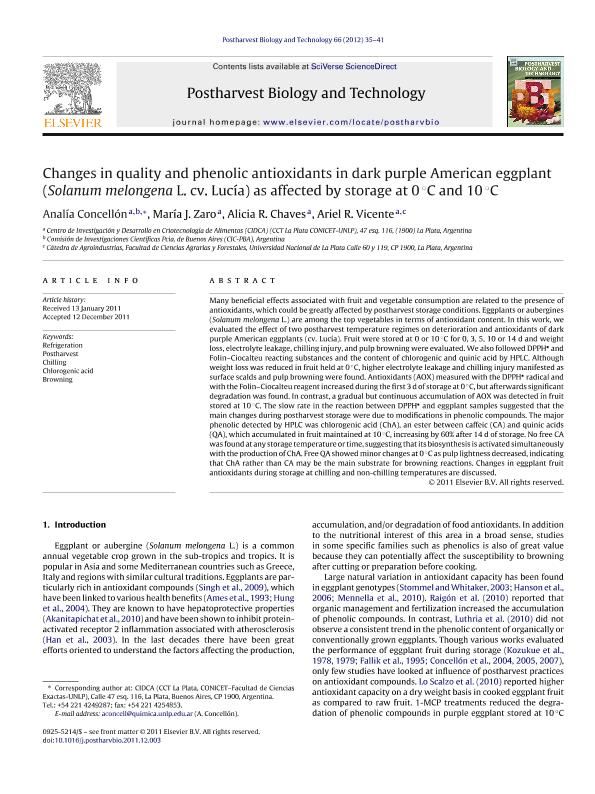Mostrar el registro sencillo del ítem
dc.contributor.author
Concellón, Analía

dc.contributor.author
Zaro, Maria Jose

dc.contributor.author
Chaves, Alicia Raquel

dc.contributor.author
Vicente, Ariel Roberto

dc.date.available
2020-06-22T15:07:56Z
dc.date.issued
2012-04
dc.identifier.citation
Concellón, Analía; Zaro, Maria Jose; Chaves, Alicia Raquel; Vicente, Ariel Roberto; Changes in quality and phenolic antioxidants in dark purple American eggplant (Solanum melongena L. cv. Lucía) as affected by storage at 0°C and 10°C; Elsevier Science; Postharvest Biology and Technology; 66; 4-2012; 35-41
dc.identifier.issn
0925-5214
dc.identifier.uri
http://hdl.handle.net/11336/107795
dc.description.abstract
Many beneficial effects associated with fruit and vegetable consumption are related to the presence of antioxidants, which could be greatly affected by postharvest storage conditions. Eggplants or aubergines (Solanum melongena L.) are among the top vegetables in terms of antioxidant content. In this work, we evaluated the effect of two postharvest temperature regimes on deterioration and antioxidants of dark purple American eggplants (cv. Lucía). Fruit were stored at 0 or 10 °C for 0, 3, 5, 10 or 14 d and weight loss, electrolyte leakage, chilling injury, and pulp browning were evaluated. We also followed DPPH and Folin–Ciocalteu reacting substances and the content of chlorogenic and quinic acid by HPLC. Although weight loss was reduced in fruit held at 0 °C, higher electrolyte leakage and chilling injury manifested as surface scalds and pulp browning were found. Antioxidants (AOX) measured with the DPPH radical and with the Folin–Ciocalteu reagent increased during the first 3 d of storage at 0 °C, but afterwards significant degradation was found. In contrast, a gradual but continuous accumulation of AOX was detected in fruit stored at 10 °C. The slow rate in the reaction between DPPH and eggplant samples suggested that the main changes during postharvest storage were due to modifications in phenolic compounds. The major phenolic detected by HPLC was chlorogenic acid (ChA), an ester between caffeic (CA) and quinic acids (QA), which accumulated in fruit maintained at 10 °C, increasing by 60% after 14 d of storage. No free CA was found at any storage temperature or time, suggesting that its biosynthesis is activated simultaneously with the production of ChA. Free QA showed minor changes at 0 °C as pulp lightness decreased, indicating that ChA rather than CA may be the main substrate for browning reactions. Changes in eggplant fruit antioxidants during storage at chilling and non-chilling temperatures are discussed.
dc.format
application/pdf
dc.language.iso
eng
dc.publisher
Elsevier Science

dc.rights
info:eu-repo/semantics/openAccess
dc.rights.uri
https://creativecommons.org/licenses/by-nc-sa/2.5/ar/
dc.subject
REFRIGERATION
dc.subject
POSTHARVEST
dc.subject
CHILLING
dc.subject
CHLOROGENIC ACID
dc.subject
BROWNING
dc.subject.classification
Alimentos y Bebidas

dc.subject.classification
Otras Ingenierías y Tecnologías

dc.subject.classification
INGENIERÍAS Y TECNOLOGÍAS

dc.title
Changes in quality and phenolic antioxidants in dark purple American eggplant (Solanum melongena L. cv. Lucía) as affected by storage at 0°C and 10°C
dc.type
info:eu-repo/semantics/article
dc.type
info:ar-repo/semantics/artículo
dc.type
info:eu-repo/semantics/publishedVersion
dc.date.updated
2020-06-08T15:20:19Z
dc.identifier.eissn
1873-2356
dc.journal.volume
66
dc.journal.pagination
35-41
dc.journal.pais
Países Bajos

dc.journal.ciudad
Amsterdam
dc.description.fil
Fil: Concellón, Analía. Provincia de Buenos Aires. Gobernación. Comisión de Investigaciones Científicas. Centro de Investigación y Desarrollo en Criotecnología de Alimentos. Consejo Nacional de Investigaciones Científicas y Técnicas. Centro Científico Tecnológico Conicet - La Plata. Centro de Investigación y Desarrollo en Criotecnología de Alimentos. Universidad Nacional de La Plata. Facultad de Ciencias Exactas. Centro de Investigación y Desarrollo en Criotecnología de Alimentos; Argentina
dc.description.fil
Fil: Zaro, Maria Jose. Provincia de Buenos Aires. Gobernación. Comisión de Investigaciones Científicas. Centro de Investigación y Desarrollo en Criotecnología de Alimentos. Consejo Nacional de Investigaciones Científicas y Técnicas. Centro Científico Tecnológico Conicet - La Plata. Centro de Investigación y Desarrollo en Criotecnología de Alimentos. Universidad Nacional de La Plata. Facultad de Ciencias Exactas. Centro de Investigación y Desarrollo en Criotecnología de Alimentos; Argentina
dc.description.fil
Fil: Chaves, Alicia Raquel. Provincia de Buenos Aires. Gobernación. Comisión de Investigaciones Científicas. Centro de Investigación y Desarrollo en Criotecnología de Alimentos. Consejo Nacional de Investigaciones Científicas y Técnicas. Centro Científico Tecnológico Conicet - La Plata. Centro de Investigación y Desarrollo en Criotecnología de Alimentos. Universidad Nacional de La Plata. Facultad de Ciencias Exactas. Centro de Investigación y Desarrollo en Criotecnología de Alimentos; Argentina
dc.description.fil
Fil: Vicente, Ariel Roberto. Provincia de Buenos Aires. Gobernación. Comisión de Investigaciones Científicas. Centro de Investigación y Desarrollo en Criotecnología de Alimentos. Consejo Nacional de Investigaciones Científicas y Técnicas. Centro Científico Tecnológico Conicet - La Plata. Centro de Investigación y Desarrollo en Criotecnología de Alimentos. Universidad Nacional de La Plata. Facultad de Ciencias Exactas. Centro de Investigación y Desarrollo en Criotecnología de Alimentos; Argentina. Universidad Nacional de La Plata. Facultad de Ciencias Agrarias y Forestales; Argentina
dc.journal.title
Postharvest Biology and Technology

dc.relation.alternativeid
info:eu-repo/semantics/altIdentifier/url/https://www.sciencedirect.com/science/article/abs/pii/S0925521411002900
dc.relation.alternativeid
info:eu-repo/semantics/altIdentifier/doi/http://dx.doi.org/10.1016/j.postharvbio.2011.12.003
Archivos asociados
